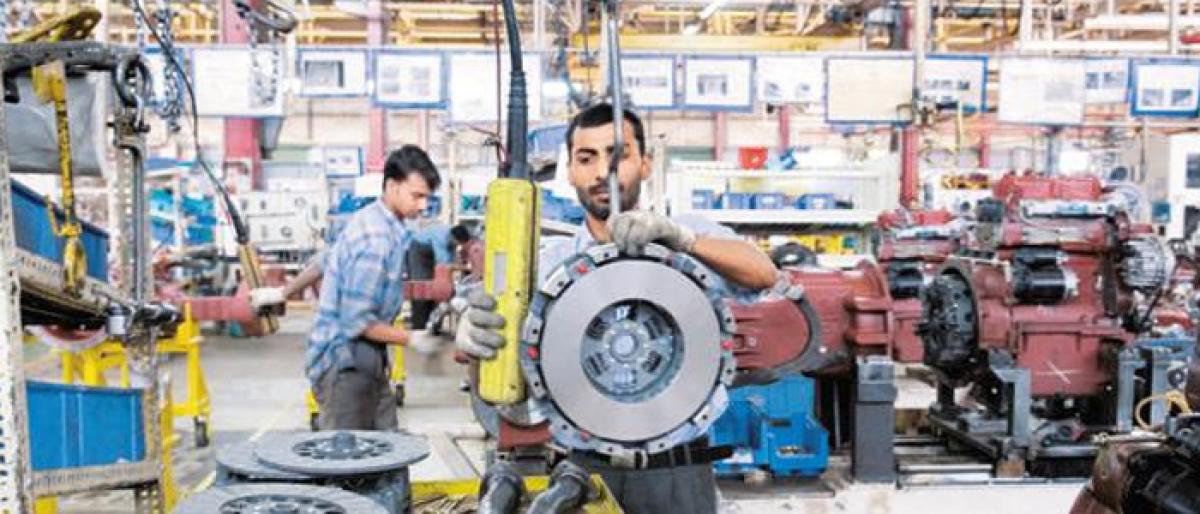Live
- GMR Airports Unveils AI-Powered Digital Twin Platform to Transform Airport Operations
- India poised to become leading maritime player: PM Modi
- Top Causes of Kidney Stones and How to Recognize Silent Symptoms
- India’s renewable energy capacity logs 14.2 pc growth at 213.7 GW
- Winter Session of Odisha Assembly adjourned sine die
- Biden calls Trump's tariff approach 'major mistake'
- After Drama Over Eknath Shinde’s Chief Minister Race, Maharashtra Cabinet Formation Faces New Tensions
- Egyptian FM, Blinken discuss recent developments in Syria
- Iran's supreme leader says Syria's developments result of US-Israeli 'plot'
- Elon Musk to Purchase $100 Million Luxury Mansion Next to Donald Trump's Mar-a-Lago, Report Reveals
Just In

The growth rate of India\'s GDP in the last quarter of last fiscal has surprised even die-hard optimists. India\'s economy grew by 7.7 per cent in the three months ended March 31, the fastest pace in seven quarters, signalling a turnaround that could help the government politically to some extent in the elections next year.
The growth rate of India's GDP in the last quarter of last fiscal has surprised even die-hard optimists. India's economy grew by 7.7 per cent in the three months ended March 31, the fastest pace in seven quarters, signalling a turnaround that could help the government politically to some extent in the elections next year.
This growth rate is above China's latest growth rate of 6.8 per cent. According to the latest data released by the Central Statistics Office, GDP rose at 7.7 per cent in the fourth quarter of 2017-18 compared with 6.1 per cent in the same period last year and a revised 7 per cent in the quarter ended December.
The economy seems to be certainly recovering, but if one breaks the numbers a little, a lot of it is essentially being driven by public expenditure. Could be that it is priming. However, this does not mean that all is really well too. Even with improving growth, problems remain aplenty. Surging crude oil prices, trade tensions between US and China and a rout in the emerging markets have clouded the economic outlook.
Sectorally, the rebound was led by the manufacturing and construction sectors, aided partly by the base effect as demonetisation had hurt activity in these sectors. Construction had seen a tremendous contraction in the corresponding quarter last year, experts analyse. The positive, however, is that the economy and the momentum is picking up.
This is something nobody anticipated. How did this happen? Well, that is the manufacturing story. India's Gross Value Addition (GVA) increased from a mere 6 per cent 7.6 per cent year-on-year. The stellar growth can be attributed to the strong performance by manufacturing and construction sector and above-trend growth in agriculture.
The improvement in industrial activity is a result of increased focus on manufacturing and construction boost. India is blessed with a very strong domestic dynamics and the external volatility is not derailing the current economic recovery. This is one of the major promises kept by the four-year-old BJP government led by Narendra Modi-Arun Jaitley duo.
The fiscal deficit deficit for 2017-18 works out to be 3.53 per cent of the GDP, broadly in line with the government's revised estimates of 3.5 per cent. The data released by the Controller General of Accounts the revenue deficit was 2.65 per cent of the GDP. The government in February had revised the fiscal deficit target for 2017-18 to 3.5 per cent from the earlier estimate of 3.2 per cent while proposing to bring down the fiscal deficit.
Final figures suggest that India has achieved a primary fiscal deficit under 0.2 per cent of GDP for the fiscal year 2017-18 that ended in March indicating progress towards fiscal health. This, therefore is the fourth consecutive year with a primary fiscal deficit less than 1 per cent of GDP.
For all critics, both domestic and foreign, the numbers speak for themselves. The BJP won't be able to turn around rural India between now and the next general elections, but, it can shore up its support among rural voters by paying more attention to rural development.

© 2024 Hyderabad Media House Limited/The Hans India. All rights reserved. Powered by hocalwire.com







